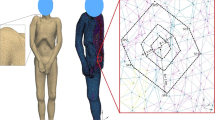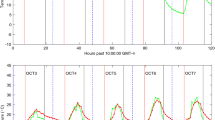Abstract
The most common method used in determining the estimated time since death in the early post-mortem phase is back-calculation based on rectal temperature decrease. Cooling experiments are essential for model generation and validation. Post-mortem temperature models are necessary to perform back-calculations. Thus far, cooling experiments have not been performed under controlled environmental conditions. The present study provides data on 84 post-mortem cooling experiments under strictly controlled environmental conditions. For a period of 5 years, starting in 2003, deceased persons with a known time of death and known environmental conditions at the death scene were transferred to a climatic chamber for the process of body cooling. The environmental temperature was programmed to the death scene temperature and kept constant throughout the process of body cooling. Rectal and ambient temperatures were measured every minute. Relevant case-specific information was summarized in a FileMaker database. The database serves as a reference tool for the comparison of real cases in forensic routine and to check the plausibility of model-derived estimates.







Similar content being viewed by others
References
De Saram GSW, Webster G, Kathirgamatamby N (1955) Post-mortem temperature and the time of death. J Crim Law Criminol Police Sci 46:562–577
Lundquist F (1956) Physical and chemical methods for the estimation of the time of death. Acta Med Leg Soc Liege 9:205–213
Fiddes FS, Patten PT (1958) A percentage method for representing the fall in body temperature after death. J Forensic Med 5(1):2–15
Marshall TK, Hoare FE (1962) Estimating the time of death–the rectal cooling after death and its mathematical expression. J Forensic Sci 7(1):56–81
Cengel AY (1998) Heat transfer: a practical approach, Internationalth edn. McGraw-Hill, New York
Mall G, Eisenmenger W (2005) Estimation of time since death by heat-flow Finite-Element model. Part I: method, model, calibration and validation. Leg Med Tokyo 7(1):1–14
Hiraiwa K, Ohno Y, Kuroda F, Sebetan IM, Oshida S (1980) Estimation of post-mortem interval from rectal temperature by use of computer. Med Sci Law 20(2):115–125
Rainy H (1869) On the cooling of dead bodies as indicating the length of time that has elapsed since death. Glasg Med J 1:323–330
Hubig M, Muggenthaler H, Mall G (2010) Influence of measurement errors on temperature-based death time determination. Int J Leg Med. doi:10.1007/s00414-010-0453-5
Henssge C, Madea B (1988) Methoden zur Bestimmung der Todeszeit an Leichen. Schmidt-Röhmhild, Lübeck
Henssge C (1979) Die Präzision von Todeszeitschätzungen durch mathematische Beschreibung der rektalen Leichenabkühlung. Z Rechtsmed 83:49–67
Lim CL, Byrne C, Lee JK (2008) Human thermoregulation and measurement of body temperature in exercise and clinical settings. Ann Acad Med Singapore 37(4):347–353
Oka T, Oka K, Hori T (2001) Mechanisms and mediators of psychological stress-induced rise in core temperature. Psychosom Med 63(3):476–486
Shields CP, Sixsmith DM (1990) Treatment of moderate-to-severe hypothermia in an urban setting. Ann Emerg Med 19(10):1093–1097
Demierre N, Wyler D, Zollinger U, Bolliger S, Plattner T (2009) Elevated body core temperature in medico-legal investigation of violent death. Am J Forensic Med Pathol 30(2):155–158
Henssge C, Althaus L, Bolt J, Freislederer A, Haffner HT, Henssge CA, Hoppe B, Schneider V (2000) Experiences with a compound method for estimating the time since death. I. Rectal temperature nomogram for time since death. Int J Leg Med 113(6):303–319
Mueller B (1937) Mastdarmtemperatur der Leiche und Todeszeit. Dtsch Z gesamte gerichtl Med 28:172–177
Lyle HP, Cleveland FP (1956) Determination of the time of death by body heat loss. J Forensic Sci 1:11–24
Simonsen J, Voigt J, Jeppesen N (1977) Determination of the time of death by continuous post-mortem temperature measurements. Med Sci Law 17(2):112–122
Henssge C (1981) Todeszeitschätzungen durch die mathematische Beschreibung der rektalen Leichenabkühlung unter verschiedenen Abkühlungsbedingungen. Z Rechtsmed 87:147–178
al-Alousi LM, Anderson RA, Worster DM, Land DV (2001) Multiple-probe thermography for estimating the post-mortem interval: I. continuous monitoring and data analysis of brain, liver, rectal and environmental temperatures in 117 forensic cases. J Forensic Sci 46(2):317–322
Acknowledgements
This work was supported by grant MA 2501/1–2 from the DFG (Deutsche Forschungsgemeinschaft).
Author information
Authors and Affiliations
Corresponding author
Electronic supplementary material
Below is the link to the electronic supplementary material.
Rights and permissions
About this article
Cite this article
Muggenthaler, H., Sinicina, I., Hubig, M. et al. Database of post-mortem rectal cooling cases under strictly controlled conditions: a useful tool in death time estimation. Int J Legal Med 126, 79–87 (2012). https://doi.org/10.1007/s00414-011-0573-6
Received:
Accepted:
Published:
Issue Date:
DOI: https://doi.org/10.1007/s00414-011-0573-6




